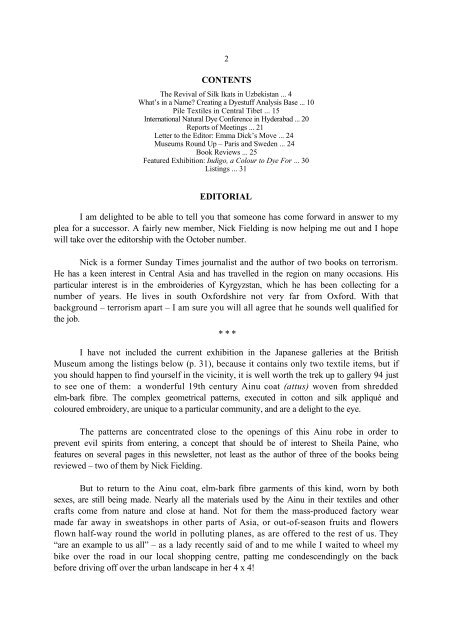download - OATG. Oxford Asian Textile Group
download - OATG. Oxford Asian Textile Group
download - OATG. Oxford Asian Textile Group
- No tags were found...
Create successful ePaper yourself
Turn your PDF publications into a flip-book with our unique Google optimized e-Paper software.
2CONTENTSThe Revival of Silk Ikats in Uzbekistan ... 4What’s in a Name? Creating a Dyestuff Analysis Base ... 10Pile <strong>Textile</strong>s in Central Tibet ... 15International Natural Dye Conference in Hyderabad ... 20Reports of Meetings ... 21Letter to the Editor: Emma Dick’s Move ... 24Museums Round Up – Paris and Sweden ... 24Book Reviews ... 25Featured Exhibition: Indigo, a Colour to Dye For ... 30Listings ... 31EDITORIALI am delighted to be able to tell you that someone has come forward in answer to myplea for a successor. A fairly new member, Nick Fielding is now helping me out and I hopewill take over the editorship with the October number.Nick is a former Sunday Times journalist and the author of two books on terrorism.He has a keen interest in Central Asia and has travelled in the region on many occasions. Hisparticular interest is in the embroideries of Kyrgyzstan, which he has been collecting for anumber of years. He lives in south <strong>Oxford</strong>shire not very far from <strong>Oxford</strong>. With thatbackground – terrorism apart – I am sure you will all agree that he sounds well qualified forthe job.* * *I have not included the current exhibition in the Japanese galleries at the BritishMuseum among the listings below (p. 31), because it contains only two textile items, but ifyou should happen to find yourself in the vicinity, it is well worth the trek up to gallery 94 justto see one of them: a wonderful 19th century Ainu coat (attus) woven from shreddedelm-bark fibre. The complex geometrical patterns, executed in cotton and silk appliqué andcoloured embroidery, are unique to a particular community, and are a delight to the eye.The patterns are concentrated close to the openings of this Ainu robe in order toprevent evil spirits from entering, a concept that should be of interest to Sheila Paine, whofeatures on several pages in this newsletter, not least as the author of three of the books beingreviewed – two of them by Nick Fielding.But to return to the Ainu coat, elm-bark fibre garments of this kind, worn by bothsexes, are still being made. Nearly all the materials used by the Ainu in their textiles and othercrafts come from nature and close at hand. Not for them the mass-produced factory wearmade far away in sweatshops in other parts of Asia, or out-of-season fruits and flowersflown half-way round the world in polluting planes, as are offered to the rest of us. They“are an example to us all” – as a lady recently said of and to me while I waited to wheel mybike over the road in our local shopping centre, patting me condescendingly on the backbefore driving off over the urban landscape in her 4 x 4!
















